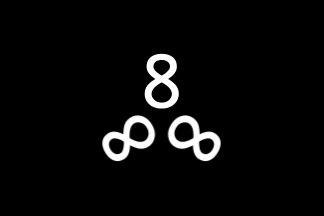 image by Eugene Ipavec, 4 August 2010
image by Eugene Ipavec, 4 August 2010
Last modified: 2024-03-02 by rob raeside
Keywords: colombia | trade union |
Links: FOTW homepage |
search |
disclaimer and copyright |
write us |
mirrors
Editorial Remark: It must be noted that all the opinions are of the authors and not of FOTW. Our site is non-political and concentrates only on vexillological issues.
See also:
Aside from the three main national unions existing in
Colombia, there are also other unions wich represent workers from
a particular economic sector, like the USO of
the oil industry.
The other major sector union is FECODE (Federación Colombiana de
Educadores, or Colombian Teachers Federation, official website: www.fecode.edu.co).
It represents teachers nationwide.
There was a time during the 20th century where other sector
unions and company's unions were very important as well, but now
the three main national unions, (CTC, CGT and CUT, and now the
UTRACUN), plus the sectoral USO and FECODE are the main
organizations.
Neither USO or FECODE wanted to merge with any of the national
unions because they still hold much negotiating power alone that
would be lost if they merge with other unions, as happened with
other important unions that merged to form the three main
Centrales Obreras (Workers Centrals), as they are locally called,
in order to refer to them as the main representatives of Colombian
workers.
However there is an estimate, that only 20% of Colombian workers
is represented in these national unions, or Central, also because
private companies also have their own unions, but these workers
would loose benefits if they were to merge into any of these
three main Centrals, because not only these Centrals support
labor rights, but also may support political candidates,
specially leftist candidates, coming mainly from the PDA (Polo Democrático Alternativo, or
Alternative
Democratic Pole), which is the merger of AD and PDI parties.
E.R., 23 February 2008
 image by Eugene Ipavec, 4 August 2010
image by Eugene Ipavec, 4 August 2010
I am requesting your help please in drawing a flag I saw quite a long time
ago (May 8-10 years ago). It is a flag seen during a labor protest in which
Colombian workers demanded the then-traditional "8 hours labour, 8 hours
recreation, 8 hours rest". The 8-hour day " (The eight-hour day, as it came to
be known) movement or 40-hour week movement, also known as the short-time
movement, had its origins in the Industrial Revolution in Britain, where
industrial production in large factories transformed working life and imposed
long hours and poor working conditions. With working conditions unregulated, the
health, welfare and morale of working people suffered. The use of child labour
was common. The working day could range from 10 to 16 hours for six days a week.
Robert Owen had raised the demand for a ten-hour day in 1810, and instituted it
in his socialist enterprise at New Lanark. By 1817 he had formulated the goal of
the eight-hour day and coined the slogan Eight hours labour, Eight hours
recreation, Eight hours rest. Women and children in England were granted the
ten-hour day in 1847. French workers won the 12-hour day after the February
revolution of 1848. A shorter working day and improved working conditions were
part of the general protests and agitation for Chartist reforms and the early
organization of trade unions."
Source:
http://en.wikipedia.org/wiki/Eight-hour_day
One can see several banners regarding this labor demand, here:
-
image at website:
http://cotarelo.blogspot.com/2008/06/sesenta-y-cinco-horas.html )
-
image at website:
http://gonzaloluchadorsocial.blogspot.com/ )
It seems that the Colombian flag I saw, was surely inspired by this.
The flag I remember was a plain horizontal black background (I don't know if
this was the flag's true color, since the image appears in a b/w photograph of
the time, nearly 1920's), with three number 8's in the middle, resembling
coincidentally the Mercedes car manufacturer logo in the way they are arranged
(please see scanned image). If I'm not mistaken, this flag came to be during the
time of the "Banana Massacre" (Masacre de las Bananeras) (
http://en.wikipedia.org/wiki/Banana_massacre and
http://es.wikipedia.org/wiki/Masacre_de_las_Bananeras ) incident, in 1928,
where a massive labor strike took place by the local workers against their
employers, the United Fruit Company (which merged with AMK in 1970 to become the
United Brands Company and in 1984 it became to be known by tis current name of
Chiquita Brands International) for their poor labor conditions. The company had
a deep and long-lasting impact on the economic and political development of
several Latin American countries. Critics often accused it of exploitative
neocolonialism and described it as the archetypal example of the influence of a
multinational corporation on the internal politics of the so-called "banana
republics" (a term coined by O. Henry, the pseudonym of the American writer
William Sydney Porter).
Source:
http://en.wikipedia.org/wiki/United_Fruit_Company
The flag was seen in the series of books titled "Nueva Historia de Colombia" (by
Editorial Planeta, publihsed in 1989, with several volumes) as seen on this
picture:
http://3.bp.blogspot.com/_QxGNYTqsA4Y/RovfQDmNAiI/AAAAAAAAACE/voX3dzDHcGQ/s1600-h/IMG_0001.JPG
However I don't remember very well the volume and the page where I saw this
image.
Esteban Rivera, 1 August 2010
AUGURA (Asociación de Agricultores y Ganaderos de Urabá, Association of
Farmers and Cattle Breeders of Uraba) was established in 1963 to represent
farmers and cattle breeders in the northwestern subregion of Urabá, in the
Department of Antioquia.
It changed its name in 1966 to Asociación de Bananeros y
Agricultores de Urabá (Association of Banana growers and Farmers of
Uraba), again in 1986 to Asociación de Bananeros de Urabá (Association
of Banana growers of Uraba) and finally it settled on Asociación de
Bananeros de Colombia (Association of Banana growers of Colombia), but
still carrying the marquee.
Source: http://www.augura.com.co/augura/resena-historica/
For additional information go to: AUGURA (official website)
The flag is a horizontal flag with the
logo in the middle
between two golden stripes, followed by two thin white stripe, ending
in two green stripes on the top and on the bottom, respectively from
the inside outwards as seen
here.
The AUGURA flag is seen in the picture the fourth flag from left to right.
Source:
http://www.augura.com.co/comunicaciones/augura-informa/augura-informa-edicion-abril-de-2016-asamblea-augura/
Esteban Rivera, 07 May 2016
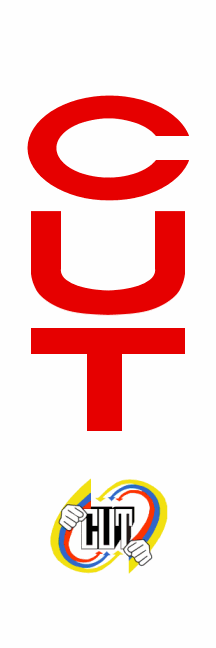 image by Eugene Ipavec, 3 September 2007
image by Eugene Ipavec, 3 September 2007
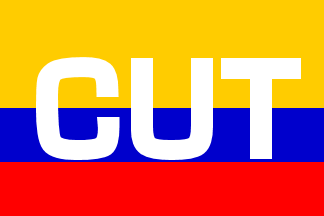 image by Eugene Ipavec (based on original by Jaume
Ollé), 3 September 2007
image by Eugene Ipavec (based on original by Jaume
Ollé), 3 September 2007
variant
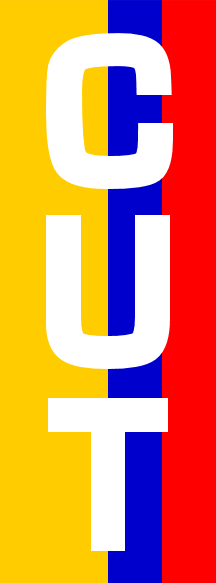 image by Eugene Ipavec (based on original by Jaume
Ollé), 3 September 2007
image by Eugene Ipavec (based on original by Jaume
Ollé), 3 September 2007
variant
.gif) image by Eugene Ipavec, 3 September 2007
image by Eugene Ipavec, 3 September 2007
logo
Central Unitaria de Trabajdores de Colombia (CUT) is Colombia's biggest trade
union. It's official website is located at www.cut.org.co
where you can see their flag: CUT letters in red, on a white
vertical banner. Their Coat of Arma is seen on the upper right
corner on their homepage. Another variants of the flag was
reported by Jaumé Ollé in 2004.
The CUT was founded on November 15-17, 1986, but it traces back
its roots to 1936. On August 7, 1936 the Confederación de
Trabajadores de Colombia (CTC) (Colombian Workers Confederation)
was established of Liberal and Communist tendencies. It adhered
to the Confederación de Trabajadores de América Latina (CTAL)
(Latin American Workers Confederation (LAWC)) and later on to the
Federación Sindical Mundial (FSM) (World Federation of Trade
Unions (WFTU)). In May 1950 it breaks away from the
Confederación de Trabajadores de América Latina and the
Federación Sindical Mundial by a guideline issued by the Partido Liberal Colombiano and
instead it adheres to the Confederacióin Interamericana de
Trabajadores (CIT) (Interamerican Workers Confederation (IWC).
Aside from the CTC, on June 12, 1946 the Unión de Trabajadores
de Colombia (UTC) (Colombian Workers Union) was established,
based on Christian ideas. On May 1, 1964 the UTC evolves into the
Confederación Sindical de Trabajadores de Colombia (CSTC)
(Colombian Workers Trade Union Confederation). This recently
created orgnization addheres to the Congreso Permanente de Unidad
Sindical de los Trabajdores de América Latina y el Caribe
(CPUSTAL) (Latin American and Caribbean Workers Trade Union
Permanent Congress (LAWTUPC)) and later to the Federación
Sindical Mundial (World Federation of Trade Unions (WFTU))
becoming the foremost trade union in Colombia. Later on April 30,
1971 a dissident group within the UTC forms the Confederación
General del Trabajo (CGT) (Labor General Confederation) with
a Social Democratic-Christian tendency. The CGT
is affiliated to the Central Latinoamericana de Trabajadores
(CLAT)(Latin American Workers Central (LAWC)) and to the
Conferencia Mundial del Trabajo (CMT)(World Conference Labour
(WCL)).
Apart from these, other non-confederated trade unions in Colombia
emerge as well, being labeled as Non-Confederated Trade Tnions,
because they were trade unions specifically for a company or
representing an economic sector, some with National importance,
others with State and Local importance. Among them are FENALTRASE
(Transportation trade union), FENASINTRAP, FEDEPETROL (Oil
industry trade union), FECODE (Teachers trade union), SITTELECOM
(Telecom, the State's biggest telecommunications company before
being privatized), BANCARIOS (union of banks' trade unions),
gathering public education trade unions, state-owned companies
trade unions, bank trade unions, transportation trade unions,
health industry and hospitals trade unions, oil and energy trade
unions. Then on July 14, 1985, FENALTRASE promotes all
Non-Confederated Trade Unions together around the CSTC, signed by
the following groups: Usitras, Asicun, , Sintraferrovías,
Sintraicollantas, Fecode, Sintrapopular (which comprised the
union of the following trade unions: Fenaltrase,
Fenasibancol, Fedepetrol, Cusi, Central Sindical Revolucionaria,
Festrac and the Uso). Then the Coordinadora de Unidad Sindical
(CUS) or Trade Union Coordination (TUC) was created, by: CSTC,
Confederated Trade Unions, UTC and CTC, to develop into bigger
trade union. Then finally on November 15-17, 1986, all of the
previously mentioned trade unions (UTC, CSTC, CTC and the
Confederated Trade Unions) merge to form the CUT.
Source: www.cut.org.co.
E.R., 3 September 2007
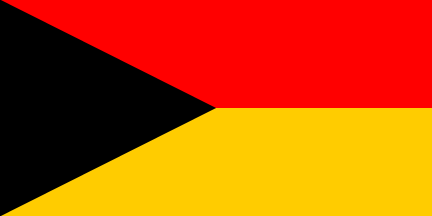 image by Eugene Ipavec., 6 March 2008
image by Eugene Ipavec., 6 March 2008
.gif) image by Eugene Ipavec, 6 March 2008
image by Eugene Ipavec, 6 March 2008
logo
This is another Colombian workers union, called CGT
(Confederación General del Trabajo, General Labor
Confederation). The CGT was called the CGTD
as can be seen on their homepage a picture
of the CGT's National Executive Committee, in which the logo of
the CGTD is on the background of this meeting.
The CGT official flag can be seen at www.cgtcolombia.org.
It has a very similar pattern compared to the Czech Republic flag - it has two horizontal
stripes, the color being red (on the top fringe),
symbolizing the blood of the workers spilled during their
struggles, the yellow (on the bottom fringe) is symbolizing the
country's richness in natural resources, and the black (on the
triangle) symbolizing the will of the workers.
The CGT official logo is at www.cgtcolombia.org.
It is the three letters of the CGT in red on an anvil with a hand
holding a torch. It is based on the CGTD
logo. CGT official website is at www.cgtcolombia.org.
E.R., 6 March 2008
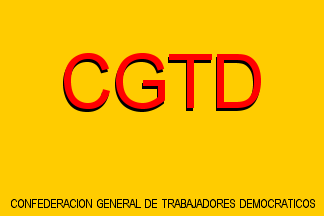 image by Eugene Ipavec (based on original by Jaume
Ollé), 3 September 2007
image by Eugene Ipavec (based on original by Jaume
Ollé), 3 September 2007
flag
.jpg) image contributed by Jaume Ollé
image contributed by Jaume Ollé
logo
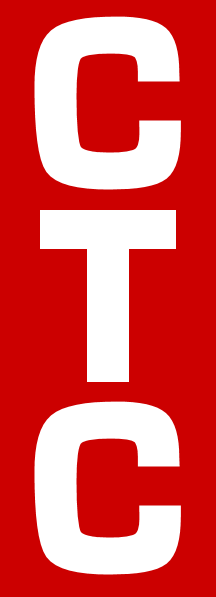 image by Eugene Ipavec (based on original by Jaume
Ollé), 3 September 2007
image by Eugene Ipavec (based on original by Jaume
Ollé), 3 September 2007
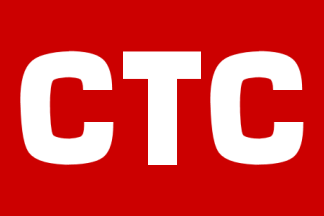 image by Eugene Ipavec (based on original by Jaume
Ollé), 3 September 2007
image by Eugene Ipavec (based on original by Jaume
Ollé), 3 September 2007
Founded in 1935.
E.R., 3 September 2007
The CTC has its own official website, at www.ctc-colombia.com.co.
The Coat of Arms can also be found on their homepage. For
more on their historical backgrounds, see this page.
E.R., 23 February 2008
 image by Eugene Ipavec (based on original by Jaume
Ollé), 3 September 2007
image by Eugene Ipavec (based on original by Jaume
Ollé), 3 September 2007
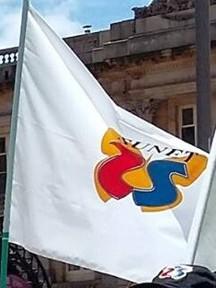 image located by Esteban
Rivera, 16 June 2022
image located by Esteban
Rivera, 16 June 2022
The "Sindicato Unitario Nacional de Trabajadores del Estado, SUNET" (National
Union of State Workers) is a trade union flag that aims to represent all workers
that are employed by the State at the national level. They have branches for
each Department and it was established on October 20, 2011 although around 2017
several changes were being made which derived, by initiative of several local
unions such as Suntramunicipios Caldas, Sintraoficiales Floridablanca,
Sintraesemdentol, Sintrapublimag, Sintrasema, Sinalserpub y Sintraestatales, and
approval by the CUT, to reform its Statutes, which were issued on July 5-6,
2018. It is affiliated as a chapter representing public service workers, within
the CUT.
Sources:
https://sunet.co/apc-aa-files/2d33553ecbb04371c533ffd0756a914e/estatutos-sunet-julio-2018_2.pdf
https://sunet.co/es/noticias/comunicado-de-respaldo-de-sunet-a-trabajadores-del-sector-educacion
and
https://www.integracionsocial.gov.co/index.php/171-transparencia/organizaciones-sindicales/4852-sindicato-unitario-nacional-de-trabajadores-del-estado-sunet
The flag is a horizontal white background with the logo in the middle.
Source:
https://sunet.co/es/galeria-de-imagenes/galeria?galeria=%27
For
additional information go to SUNET (official website):
https://sunet.co/
Esteban
Rivera, 16 June 2022
.jpg) image located by Esteban
Rivera, 16 June 2022
image located by Esteban
Rivera, 16 June 2022
The logo is two crossed S capital letters, facing each others' backs, left
in red (for socialism), right in blue (for conservativism), over a yellow
background in what appears to be a butterfly silhouette, most likely to
resemble "the butterfly effect" in which a change is set in motion
even from the slightest variation.
Source:
https://sunet.co
Esteban
Rivera, 16 June 2022
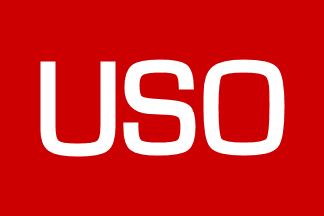 image by Eugene Ipavec (based on original by Jaume
Ollé), 3 September 2007
image by Eugene Ipavec (based on original by Jaume
Ollé), 3 September 2007
It is the trade union of the Ecopetrol
company (Empresa Colombiana de Petróleos, Colombian Oil
Company), Colombia's biggest State owned company until 2007 when,
in a process of privatization starting on August 27 and ending on
September 25, it will sell some of its shares to seek capital on
the market, on different stages onwards.
Jaume Ollé reported in 2004 also on another flag seen
here in a photo.
The USO was officially established in 1937, but it had been active underground
since early 1922. It has its own official website at www.usofrenteobrero.org.
E.R., 3 September 2007
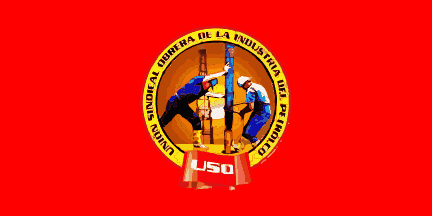 image by Zoltan Horvath, 11 November 2012
image by Zoltan Horvath, 11 November 2012
There's another version of the USO flag, seen
here.
Source:
http://www.lasillavacia.com/historia/el-vagon-sindical-se-le-pega-la-locomotora-minera-35544
Esteban Rivera, 27 August 2012
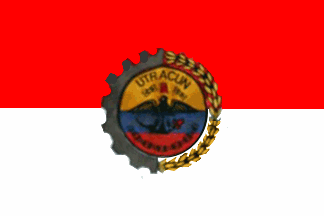 image by Eugene Ipavec, 19 March 2008
image by Eugene Ipavec, 19 March 2008
There is a new national workers union being set up in
Colombia. It's called UTRACUN (Unión de Trabajadores de Cundinamarca, Cundinamarca Workers Union).
It started as a Union for Cundinamarca workers. It was
established on April 30, 1951, lobbying for better wages, social
security coverage among other requests. It is new in terms of
nationwide operation. At first it was mainly a regional union.
However it expanded up to the point that it currently has
national representation. It is in favor of free market practices
and supports close relations between employers and employees, as
well, as free trade agreements among countries, and other free
market practices. In this views, it opposes the other three
big national nationwide unions, CGT, CTC and CUT.
It encompasses in total 66 unions from textiles, flowers,
beverages, food, plastic, metal mechanics, and mining
companies, from Antioquia, Caldas, Cundinamarca, Risaralda and
Valle, with over 45,000 affiliates.
The flag of the Union can be seen in article
at El Tiempo newspaper. The flag is a red over white, horizontal
flag, with the Coat of Arms of the Department of Cundinamarca in
the middle, surrounded by a half gray cogwheel on the
right and a half yellow laurel wreath on the
left.
UTRACUN official website is at www.utracun.com.co.
E.R., 19 March 2008




